
Eigenes innovatives Lehrkonzept: Forschendes Lernen und Scientific Speed Dating (2016-2017)
At the anaesthesiological outpatient department of Erlangen University Hospital (EUH) processes were analysed in 2016 for two weeks to identify weak points. The goals were to optimize patient and staff satisfaction with preoperative risk evaluation and to reduce waiting time. 114 patients had been observed.
- Patients had to wait for at least 48 minutes on an average before talking to the doctor.
- Examination of paper files took 11 minutes on average, talking with the doctor about 16 minutes.
- 34 % of all viewed patients rated waiting time as not acceptable in their point of view, compared to 60 % as acceptable.
- 90 % agreed that perioperative anaesthesiological evaluation was very important.
391.000 assigned complete preoperative datasets are available in the hospital-wide data warehouse. Moreover, an important approach in form of a prototype for prefilling paper based questionnaires was developed in a project as part of the interdisciplinary teaching event “Scientific Speed Dating” (at University of Erlangen-Nuremberg, faculties of medicine and engineering) last semester (WS 2016/2017). Two students of medical engineering helped with the programming of the web application. Project leader and supervisor was Dr. med. Stefan Wagner, MHBA. After completion of the event the code base was improved by him to generate the prototype. Information of completed anaesthesia protocols is extracted and imported into a relational Oracle database in the background without any user interaction.
However, the data structure is very complex for secondary data reuse. The data warehouse helps solving this problem. It includes data from nearly all different health information systems such as operation protocols, laboratory, radiology and instrument-based diagnostics. The data warehouse imports a huge amount of information from a great number of health information systems every night, also datasets from the AIMS. Advantage of the data warehouse is the logical data structure. For our preliminary data analysis we exported datasets of former evaluation visits for the categories preoperative status, findings and visit as well as corresponding accounting data including diagnoses and procedures. Free text information and structured entries were included. We selected more than 64.000 patients (more than 82.000 treated cases), starting at the age of 18 and with operations during the years 2013 to 2015.
All datasets were pseudonymised to ensure privacy and to involve two students studying medical engineering at FAU. 5 ECTS credits were granted to each of them for their support. The CSV export files have been imported into a MySQL open source project database (MariaDB 10.1.13). Furthermore, we installed an Apache webserver (Apache 2.4.17, 8 GB RAM, Windows Server operating system) with PHP (Version 5.6.23 and as a follow-up step 7.1.2), for development and testing purposes. Paper based patient questionnaires consist of 24 main questions including sub-categories. We selected the most important items for our prototype development. Doctors in every evaluation visit asked for:
- height
- weight
- age
- gender
- former operations
- current medications
- allergies or oversensitivities
- heart
- circulatory or blood vessel diseases, diseases of the respiratory tract (breathing passages) or lungs
- thyroid diseases
- kidney diseases
- nervous system
- smoking and drinking.
NarkoData offers doctors preselection of items for different diseases and input of further free text. Apart from this style of documentation, including shortcuts for diseases, differs significantly between staff members. Data analysis, possibilities of filtering and evaluation become even more difficult. Dr. Wagner, not only active at all main operation facilities of our hospital, but also performing many visits, took a deep look at structure and contents of the datasets. Corresponding items of the questionnaire and of NarkoData were successfully identified. The paper form exists in two versions: a printed document and a PDF-document, which cannot be edited.
Therefore, a web application prototype was developed, including all paper version questions and items. Now easy data entry was achieved, using a web browser, with possibilities of item pre-selection. Relational database queries were implemented using PHP and matching items. These queries took into account not only structured items but also free text comments. The fields “yes” and “no”, e.g. for existing diseases, allergies and long-term medication use, were also pre-checked. As a result the questionnaire could be prefilled automatically by entering a patient identification number. Only the last hospital stay was recognized in cases of more than one visit. Thus, the use of only the latest information could be ensured.
Free text fields about height, weight, former operations, current drugs, allergies, smoking and drinking were prefilled as well. Data updates might be necessary. All automatic evaluated information was loaded into an editable browser form. Finally, it could be exported to PDF-format and stored using the free fpdf library. At the moment the execution of the relational database queries takes 2 minutes on average for one run, without using any table indexes or other database performance optimization.
Weiterführende Informationen zum Forschenden Lehren und Lernen.
